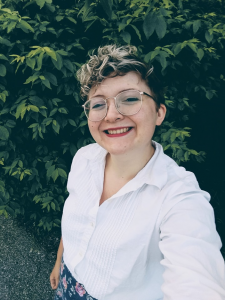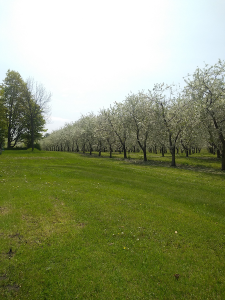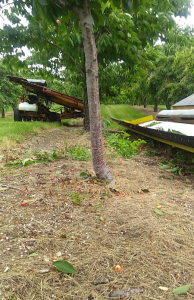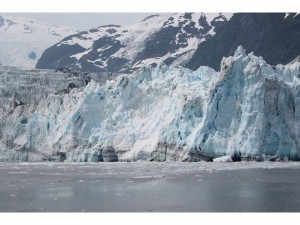In January 2020, the Tech Forward Initiative on Sustainability and Resilience held a Listening Session to learn more about the concerns, priorities, and visions shared by campus and community members for the future of sustainability at Michigan Tech. The summary of that session is available here. Additional comments can still be submitted here.
This is a guest post from Lena Stenvig, an undergraduate student at Michigan Tech. Lena is studying Computer Science and minoring in Environmental Studies. Lena took the photos included in this blog post. She can be reached at lsstenvi@mtu.edu
The cherry orchard at Garthe Farms LLC
America is all about its family-owned farms. From its popular food chains serving America-grown burgers to its corn-mazes in the fall attracting people from all around, none of it would be possible without the original small-town humble farmers that do their job equally for supporting their families and for the love of what they do every day; but now our farmers need help. When people moved away from their family farms over to less body-intensive jobs for work, fewer farms began producing more product on more land. Even so, many farmers struggle to produce enough crop to sustain themselves and their family. Around 91 percent of farming families have at least one family member working at a job that is not the farm. This is where Behind the Meter, or BTM comes in.
Behind the meter is a means of producing your own energy so that you are not pulling all of the energy you use from the grid, and as a result pay less for your electricity bill. A popular technique to behind-the-meter is installing solar-panels in one’s yard on upon the roof. In this way a household can produce green energy to lower its carbon footprint and can save on the electricity bill. A typical household has room for a few solar panels. Enough to sustain itself for most of the summer months, but usually not enough when the winter heating bill kicks in. A modern American farm has much more land than your typical resident. Even if most of it is used for farming, there are certainly space that could easily be allocated for a small solar farm. Having worked for Garthe Farms LLC this summer, a cherry farm deep in cherry country near Traverse City, MI, I have seen first-hand where and how this can work. My uncle, Gene Garthe, runs this farm and in recent years invested in four large solar panels that sit in empty space near the driveway nearing the farm house. These four solar panels produce enough energy to run what electricity is needed for the farm, and that is all they desire and need.
Despite producing plenty of energy via solar, Garthe Farms is not a emissions-free facility. Large machinery is used to harvest the cherries from their trees. There are three machines that are necessary in cherry harvesting: the Shaker, which shakes the cherries from the trees, the Catch Frame, which catches the cherries shaken by the Shaker and conveyors them into a tub, and the tractor that takes the tubs when full to the loading dock and brings the Catch Frame a new tub in which to fill more cherries. All three of these machines require diesel fuel to run, and as much work as one can complete towards electric vehicles, it is not economically feasible at the moment to make a machine that chugs through an entire tank of fuel in eight hours of work to operate on an electrically-rechargeable battery. To make up for their fuel usage, perhaps it is better that farms simply produce a form of green energy that can make up for the amount of fossil fuels they consume.
Cherry harvest in motion: The Shaker (far) moves to the next tree while the Catch Frame (near) is receiving a new tub in which to place the harvested cherries.
In this way farmers can reverse the BTM method. If they can produce their usual crop while also producing energy in either the form of solar or wind, they can sustain their household while also receiving return on what they put out to the grid. This can work if they can have some of their own personal solar panels to run what they need to on the farm, and then working with solar or wind companies to lease certain areas of their land to be utilized for said energy production. For wind, this is easy by simply taking up a small portion of land for each windmill. The minimally invasive turbines do not take up much room on the farm and do not hinder the crops from receiving enough sunlight. Solar panels can prove to be trickier. Because of their method of energy production, solar panels would not work well in a field full of crops that also require sunlight in order to grow. For farms that grow plants that take up less room per unit such as potatoes or corn, placing solar panels in spare spaces around the field while mostly utilizing wind power might be the best option. For farms like my uncle’s, it is a different story entirely.
Much of a cherry orchard’s area is taken up by plants and grasses that grow below the trees, and the trees stand spaced approximately ten feet apart within each row. Each row stands about another twenty five feet apart. Where some farms may be only able to place solar panels near roads or at the end of rows, orchards may place the panels in these locations are more. If one row of trees were to be replaced with solar panels, the loss of trees would be fairly minimal while also adding enormous potential for solar production. Even without removing trees, placing solar panels at the end of rows would not affect the production of fruit while also receiving gain on solar production.
If we are to look closer at our American farms and examine the issues they face today, and if we can only look at the potential they hold for energy production, we may not only be able to solve the growing problem of farms going bankrupt, but also for finding a place to produce greener energy without disrupting land that is not being used and additionally would ecologically be better off as it is. In this way farmers can continue to do what they love, and not have to work more than they have to in order to pay bills and keep their farm from dying. With this I might say the path onto greener pastures might just be creating greener pastures.
The latest Humans of Michigan Tech story features Sydney, an undergrad who lives in an ambulance turned tiny home. The story barely touches the surface of the environmental, economic, and personal benefits that can come from tiny home living. Tiny homes are a great example of how environmentally responsible living is also economically beneficial – Sydney doesn’t have to pay rent or utility bills and can take advantage of the shared systems like showers and internet provided by the college campus. Sydney is not the first MTU student to live in a tiny home while completing a degree here – a student who built a tiny home on a trailer used to live in my yard, before she graduated and moved away from Houghton. There have even been discussions of developing a community of tiny houses on campus! Sydney and other students who have lived in tiny homes demonstrate that it’s possible, even in the cold snowy climate of the UP. Her story makes me wonder – How many students would live like this, if provided the opportunity to try? How can we teach more students about this possibility? What are the barriers in our way of making more environmentally and economically sound investments for qualify living through tiny homes and access to shared systems? We’re proud of you, Sydney!
Global sea level rise has long been a predicted consequence of global warming, as massive ice sheets at the poles and on mountaintops pour their melted water into the sea. (Pumping groundwater out of aquifers and onto land (which then ultimately drains into the sea) is also a culprit.) Coastal cities are already bearing the brunt of sea level rise, from aquifer incursion (making water too saline to use) to overwhelming sea walls and stormwater infrastructure.
Sea level rise is a growing threat to one of the oldest European settlements in North America. Founded by Spanish settlers in 1565, St. Augustine FL is now struggling to protect its heritage sites in the midst of profound state-level denial and delay. The likelihood of the city surviving another 450 years seem very slim. Of course, it isn’t helpful that these challenges are often overlooked in academic circles; a recent call for papers for an Urban Heritage conference has no mention of the impacts of climate change on ancient coastal cities, even though the majority of urban populations live along coastlines. Urban heritage preservation in the face of climate change impacts (floods, droughts, intense weather events, and others) will be an important area of work in the decades ahead.
On September 21st, an estimated 400,000 people gathered in New York City for what is being hailed as the “largest climate march in history.” Organized by the organization 350.0rg and dubbed “The People’s Climate March,” this event drew hundreds of thousands of individuals from around the world, representing a diverse array of organizations and groups affected by climate change, from indigenous groups to labor unions, as well as involving those who think they have some solutions, like renewable energy advocates. Celebrities of all kinds, from actors to politicians, attended the event and brought even more public attention to it. The event already has a wikipedia entry, and the organizers claim that 2,646 “solidarity events” in 162 countries also took place that day.
This kind of social movement mobilization is meant to draw attention to the public outcry about environmental issues, specifically climate change. By gathering such a mass of people together, the event is meant to indicate that there is large scale public concern about climate change and public support for policies and actions that mitigate the environmental damages being caused by our consumption, particularly of the fossil fuels that contribute to changes in the global atmosphere.
Yet therein lies the irony: people used commercial airlines to fly from across the country and around the world to participate in an event meant to draw attention to the damaging consequences of fossil fuel consumption. According to The New York Times, people came “from as close as the Bronx to as far as at least Rome.” The photo slideshow on The New York Times website highlights an art installation of melting ice, obviously intended to draw attention to the melting of glaciers already taking place as a consequence of climate change. Yet did those artists consider the fossil fuel consumption necessary to make their art sculpture?
It would be complicated indeed to calculate the environmental footprint of “the largest climate march in history” – although I suspect it would be quite large. Even though events took place in other locations, many people choose to travel to New York to participate in the big event. For me, this raises an important question: is mobilization the best we can do? Social movement scholarship suggests that we need these kinds of large scale public events to draw attention to an issue, to demonstrate public awareness and support for social change. Yet, in the specific case of climate change, how can we mobilize without further contributing to the relatively mindless consumption of fossil fuels that has become such an engrained part of our society that we may fail to see the contradiction in flying from California to New York to protest climate change? What if all the people who attended that rally simply gave up the largest contributors to climate change, like fossil fuel powered transportation and agriculture? Can we mobilize with more intention, to demonstrate the possibility of living within responsible limits in the face of climate change? How can we balance the need to mobilize for change with a need to simply, as Ghandi aptly taught, be the change we wish to see?
The US-IALE conference in Anchorage was short but sweet — great science, wonderful colleagues, and new ideas.
However, as picturesque as the setting was, it was deeply unnerving. This winter was one of the warmest on record for Alaska, and indeed for much of the past winter, Alaska was warmer than much of the eastern US. When I arrived in Anchorage, it was at least 20 degrees (F) warmer than Houghton had been, and the trees were already fully leafed-out and blooming. Several wildfires contributed to a haze around the city that marred views and made our clothes smell like a campfire; the fire season started early and is expected to be a severe one, thanks to warm weather and dry conditions in the forests.
My son and I went on a glacier tour…. truly impressive! The blue hues and striations of black sediment made them far more beautiful than I had imagined. As we watched one of the glaciers calving, I wondered if any of those glaciers would be around for my son to show his children; odds are against it. Many speakers at the conference spoke of the difficulty that our “no analog” future presents us when we try to develop management plans for our ecosystems more than a few decades out. While they were talking about the vast reorganization of species and ecosystems that we are likely to see, I thought about how I might describe things like glaciers and tundra to my grandkids….. I am certain that my words, and even my photos, won’t do them justice.
Ignore the beautiful but dysfunctional interactive website, and instead go straight to downloading the highlights or the full report. The documents are a treasure trove of data, documenting all of the changes in our climate that we have already witnessed and what is likely to come. The report offers data and projections by region, sector, and response strategies.
An academic paper and a book are emerging that have made two large bangs in the world; both examine the sustainability (or lack thereof) of wealth inequality.
As reviewed in Common Dreams, a new paper in Perspectives in Politics by Martin Gilens and Benjamin Page, “Testing Theories of American Politics“, use a robust dataset to test four different possibilities of how our governance system is currently working. They find very little support for the forms of democracy that we commonly think we have, and instead find that our system most resembles an “Economic Elite Domination” and “Biased Pluralism”. In these systems, laws and policies are shaped by those who have the most resources in society, not the majority. Given the most recent Supreme Court decision that further reduced spending limits on political races, I fear that we’re seeing our system travel through a positive feedback, where fewer limits on money in politics begets more money for those who have it, who then have more to spend on further reducing political spending limits.
Thomas Piketty’s new book (at least new translation from French to English), “Capital in the 21st Century”, likewise uses data to demonstrate how capitalism inherently drives wealth inequality when the rate of return on capital exceeds the growth rate of an economy. Rave reviews by Paul Krugman in the New York Review of Books and by Nick Pearce in the New Statesman reflect the excitement that Piketty has empirically demonstrated what we have all intuitively understood for decades: concentration of wealth into a few families is due to system dynamics, not to the talent or intelligence of the wealthy. Indeed, concentration impedes progress of both individuals and societies. Just as unfettered money drives democracies towards oligarchy, wealth unfettered by taxes (to suppress return rates on capital below the growth of the economy) allows a positive feedback of wealth begetting wealth to form without any productivity to show for it. We are experiencing the outcome of this system dynamic: increased speculation and volatility in markets as more capital seeks higher returns, and stagnant and/or declining wealth in lower classes while wealth explodes in the upper 1% and 0.1%.
These two studies illustrate not just what we are experiencing, but why we must put the brakes on these feedbacks. The concentration of wealth and its influence on our democracy are self-reinforcing. These feedbacks pull us away from the democratic society we aspire to be, where we each have an equal chance to reach our potential and have an equal say in how the rules are made.
Conservation biology is an often-dismal discipline. For every story with a happy ending, there are hundreds with a tragic one – and often beyond that, thousands that end without us ever knowing. The loss of species that endear themselves to us is always a particularly difficult goodbye.
The monarch butterfly is swiftly approaching a sad fate. Robbed of its critical food supply (milkweed) by industrial agriculture in the midwestern region of North America, fewer monarchs are able to reproduce and migrate back down to its wintering habitat in Mexico. This year, surveys of Mexican forests have recorded the lowest number of returning monarch butterflies since these surveys began. The monarch migration is a fantastic spectacle; these butterflies migrate thousands of miles in spring and fall. Their large size and colorful markings make them familiar to most, and hence their declining numbers are likely to be noticed. That is the good news.
In this conservation case, everyone can help. Planting milkweed (the native species to North America, not tropical species such as Asclepias curassavica) in your front and back yard will help replace the feeding stations that the butterflies have lost with agriculture, and allow them to build up their numbers. Large populations help the butterfly persist through late springs (which disrupt their breeding schedule) and extreme weather events that can kill them outright.
For more information on monarch biology and how to help, you can visit the Monarch Watch webpage.
[This is a post from Brad Barnett, a Ph.D student in the Environmental and Energy Policy program here at Tech.]
Last week Senator Jim Inhofe (OK-R) took a(nother) public stand against climate change science. From the Senate floor, Inhofe argued the recent polar vortex-induced freeze that affected the United States is proof climate change is a hoax. His rationale: it’s cold outside. Inhofe insisted the wave of frosty weather is evidence that global warming just isn’t happening. If it was, surely we wouldn’t be experiencing such chilling temperatures.
Inhofe is known to be a vocal opponent of climate change science and is often written off by many as another willfully-blind right-winger. His most recent comments were ridiculed because of his oversimplification of a very complex topic and resulted in the creation of the hashtag #InhofeLogic on Twitter (which led to a lot of hilarious tweets). And while much of the online world snickered at Inhofe’s tirade, the senator isn’t alone in confusing weather with long-term climate trends and subsequent opposition to climate change. And that’s no laughing matter.
Senator Inhofe and many other highly visible climate change deniers point to short-term frigid temperatures as evidence that global warming isn’t occurring. This is a fundamental misunderstanding (or misrepresentation) of climate change. The definition of “weather” is simply “the state of the atmosphere at a place and time as regards heat, dryness, sunshine, wind, rain, etc.” On the other hand, “climate” refers to “the weather conditions prevailing in an area in general or over a long period.” Climate change scientists point to long term temperature increase trends as proof that the planet is warming. And while the recent polar vortex felt extreme, scientist say these deep freezes are occurring less frequently than they did in the past providing further support of climate change.
Despite the overwhelming consensus among the world’s scientist that climate change is occurring, a portion of the American public just doesn’t believe it’s real. According to an April 2013 study conducted by the Yale Project on Climate Change Communication, 37% of Americans still don’t believe climate change is happening. Even more concerning, the percentage of Americans that do believe it is occurring decreased by 7% compared to a previous study, and the researchers mostly attributed this to the colder winter of 2012-2013. Scariest of all, less than half of all Americans (49%) believe that climate change (if it’s happening) is caused by human activities.
While it’s certainly a positive sign the majority of Americans believe climate change is real, the decline in public belief coupled with the frigid weather creates a troubling environment for policy makers who support policies to curb climate change. The climate change debate became such a hot topic last week that the White House released a video starring President Obama’s chief science advisor explaining how climate change works. Senate Democrats also publicly announced last week a new task force to advance climate change mitigation policies. What this suggests is that climate change believers on Capitol Hill are concerned that they are losing the battle of public opinion to climate change deniers. Combine this with the growing abundance of cheap shale natural gas accessible by hydraulic fracturing and petroleum from shale rock, climate change and energy policy in the United States is at a crossroads.
Educating the public (and elected officials) on the difference between temporary weather and climate trends would go a long way in removing a critical barrier to strong climate change policy. While it may seem like a very small measure, eliminating this source of confusion may help the public (and some senators) understand that global warming isn’t a joke.



